Millbrook School, Cudlee Creek, SA, Australia.
please be patient, thanks, Peg & Bill.

All photos © Bill Chartres unless otherwise acknowledged.


CUDLEE CREEK, S.A., AUSTRALIA
MILLBROOK PRIMARY SCHOOL
1879-2010
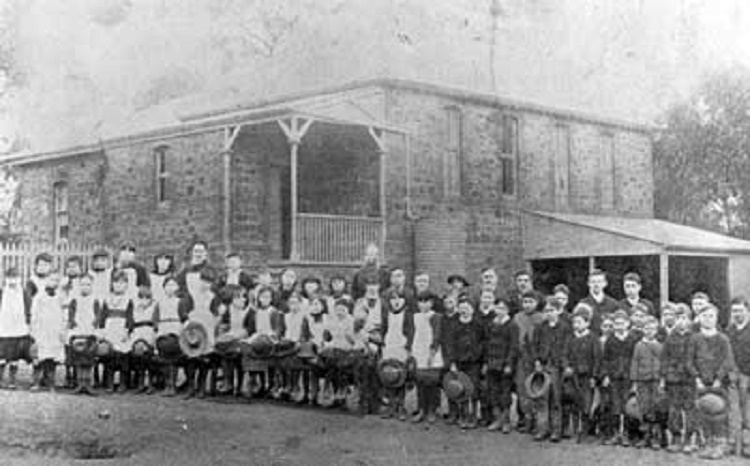 Millbrook School students with their teacher Mr J.H. Risley (Photo Peg & Bill Chartres' collection) |
Prior to the establishment of the Millbrook School in 1879, the people of the Cudlee Creek District
(Millbrook, Chain of Ponds and Cudlee Creek)
had been campaigning for an official school in the area. There had been unofficial schools established
at Millbrook, Chain of Ponds and Cudlee Creek,
but these could not cater for the total needs of the district. There was some rivalry between the three
townships as to where a new school should be
built, as the Education Department did not support schools being located within four miles (6.5km) of
each other.
A public meeting was held at the Millbrook Hotel in September 1876 to recommend to the Education
Department a suitable central location for a school to serve the area.
A meeting was held on Saturday evening, September 2, at the Millbrook Hotel, Millbrook, to consider the
advisability of urging on the Council of Education the necessity
of erecting a schoolroom and master's residence in a central position, Torren's Hill, section No. 6133.
[This is the site on Sunning Hill
Road where the school was eventually built] There were between 40 and 50 persons present.
MEETING ON SCHOOL MATTERS AT MILLBROOK.
Mr. John Tippett was voted to the chair. The Chairman said twelve months ago the Council of Education
had recommended, in a report to the House of Assembly that a school should
be erected at Millbrook, but since then nothing had been done. About this time a meeting was held at the
Morning Star, at which Mr. Hannaford, M.P., and Mr. Mooregreen, teacher of
Cudlee Creek School, were present. The latter gentleman drew attention to the regulation of the council,
which provided that, except in special cases, two schools should
not be erected within four miles of each other. These gentlemen suggested that a plan of the district
should be prepared showing the proposed site, and the residences of
the children who would attend. A committee was then formed to do this; and all their efforts were
concentrated on getting one central school, as it was thought that the
regulation referred to would prevent two schools being built in the neighbourhood. A deputation waited
on the Council of Education
[12thJune 1876] and on the Minister of Education, and were told that an official
party would visit Millbrook and view the sites mentioned, and that the
deputation would receive timely notice of their coming. He (the chairman) was sorry to say that the Minister
and the President of the Council of Education, did come, for not one
single member of the deputation was aware of their visit until just before they left; and thus the deputation
had had no opportunity of pointing out what they considered requisite.
The committee then found that in the meantime active steps had been taken to secure the erection of school
premises at Cudlee Creek. Hence this meeting had been called to express
an opinion as to the best and most central site,
for the committee felt sure that if a school were erected at Cudlee Creek there would never be one at
Millbrook. He referred to the fact that Mrs. and Miss Adey had been
teaching the school at Millbrook for the past 22 years, but they had accommodation for only 30 children,
and there were between 50 and 60 children on the west side alone
who should be attending school. Hence there was a great necessity for new premises. He read a letter from
the Minister of Education, wishing to be excused on account of
having only just then returned from his northern journey, and stating that full consideration would be
given to the claims of Millbrook, though it must be remembered that
there were many other places in need of school accommodation. Mr. Mooregreen also wrote, asking to be
excused on account of having taken charge of the correspondence relating
to getting a school built at Cudlee Creek.
Mr. Oliver Philp proposed the first resolution.
"ln consequence of there being a large number of children of a school-going age in the neighbourhood who
could attend school
on this proposed site (Torrens Hill), this meeting considers it absolutely necessary that a schoolroom
and master's residence should be erected at once,"
He thought that the older districts of the colony had as much claim for schoolhouses as the younger, and
that as they had no school accommodation, a portion of the education
grant should be spent in the neighbourhood. They advocated a central position for the new school. They did
not want to favour any place, they did not care where it was so long
as it would serve the interests of the people at Millbrook, Chain of Ponds, Prairie, Cudlee Creek, and
Holland's, Creek. And they believed that this site on Torren's Hill would
be convenient to all. Indeed, the Millbrook and Morning Star
[Chain of Ponds] people were putting themselves to inconvenience
that they might secure one good central school with a good master. He did not know why Mr. Hannaford was
using his influence in favour of a Cudlee Creek school, for that gentleman
knew that the Council would not build two schools, though he told them they would.
Mr. Hannaford had bought an old road from the Government for five shillings, and now he proposed that this
Cudlee Creek school should be built on this five shilling's worth of
land. (Laughter.) It was reported that Mr. Hanna ford had premised £20, towards a school, if built there,
and he supposed he would charge the Council £20 for the site the old
road. (Renewed laughter.) The site they proposed was offered gratuitously by Mr. John Tippett, and was not
an old road, but a fine property of two acres. (Cheers)
These Cudlee Creek people, who had been so active in trying to get the school there, had money, but no
children of a school-going age. (Hear, hear.) Mr. Ward said in his letter
that the Government were short of funds, but he (the speaker) would tell them how £700 or £800 could be
saved, and that was by building one good central school instead of two
in the extremities of the district, (Cheers.) He wished to say that there were a great many more who had
children to send who had not had an opportunity of signing the memorial.
Mr. Flinn seconded.
Mr. Keleher proposed an amendment.
"That the council be asked to erect a school on the site of the present building.
He said the majority of children resided at Millbrook (Loud cries of "No.")
Some would have to travel five miles to the site suggested in the proposition. ("No, no.")
Mr. Sutherland would like to know how many children. Mr. Keleher had between the ages of 5 and 13 years.
(Laughter.) Mr. Keleher said he had property in the district.
Mr. Oliver Philp said if Mr. Keleher thought a schoolroom was to be erected to increase the value of his
property he was very much mistaken. (Cheers.) The amendment not
being seconded, the motion was carried, only one dissenting.
Mr. W. Scott, chairman of the district council, proposed.
" That this meeting pledge themselves to support the erection of a public school and master's residence on
Torrens Hill"
He thought the site an admirable one, for it would suit all the neighbourhood, and would not clash with
the schools at Houghton, Kersbrook, and Gumeracha. He was surprised that
Mr. Hannaford should have done so much against them. (Cheers.) Mr. A. Bethune seconded. The site they
proposed would suit Cudlee Creek as well as themselves. (Hear, hear.)
He was sure two schools could not be supported, for they had had no less than eight teachers at Cudlee
Creek in the last 18 years. Besides, the site proposed by Mr. Hannaford
would not suit the Cudlee Creek people. (Hear, hear.) The motion was unanimously carried.
Mr. W. Caust proposed.
" That this meeting form themselves into a deputation to wait upon the Council of Education on Monday,
September 4, to urge upon them the desirability
of immediate action being taken to erect a school-room and a residence on the site advocated by this meeting."
The site they advocated was not the best for them, but as they believed only one school would be erected
in that neighbourhood they were anxious to have it in a
central position, so that all might participate in the benefits. The Cudlee Creek people had told him that
they would rather support the site at Torrens Hill [actually the
site where the school was built] than the one Mr. Hannaford proposed.
There were not 10 children within a mile of the site at Cudlee Creek, hence they
should oppose its adoption. (Cheers.) Mr. Houghlahan seconded.
Carried unanimously.
The Chairman said he would take that opportunity of contradicting a rumour which, he believed, Mr. Hannaford
had floated, that he had given the land so that the school might
be close to his property. It was no such thing, for it would be a positive loss to him. (Hear, hear.) But
he had done what he had rather than see the school put in a position
which was not central. He had been round to the parents, and though he had not seen all, yet there were
signatures promising the attendance of 97 children if the school were
erected on Torrens Hill. (Cheers.)
Votes of thanks were passed to the committee, to the chairman, to Mr. Scott for his attendance, and to
the proprietors of the, Advertiser for sending a reporter, and the meeting
then closed.
(MEETING ON SCHOOL MATTERS AT MILLBROOK.
(1876, September 4). The South Australian Advertiser (Adelaide, SA : 1858 - 1889), p. 6.
Retrieved April 13, 2016,from http://nla.gov.au/nla.news-article31972830)
The Education Department finally agreed to the site suggested and the Millbrook Primary School and
teachers residence was built in 1878 with the first students attending at the
begining of the 1879 school year, with Mr. John H. Risley the Head Teacher.
(It is interesting to note that the school was built to accommodate 85 students but in its first year
it had 105 students, and only one teacher!)
In 1979 Millbrook School celebrated its centenary years and we
(Peg & Bill Chartres) prepared a "Historic Display", for the occasion which was housed in the
main school room.
Much of the information on this page is a result of that work.
![]()
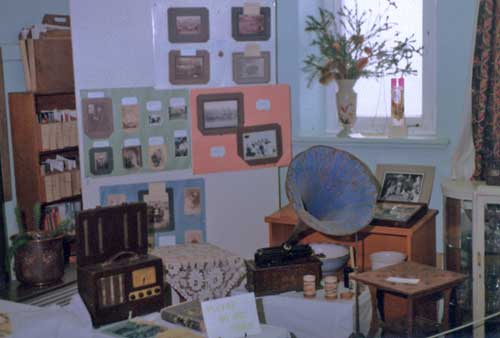
CPart of the Millbrook School Centenary Historic Display, set up by Peg & Bill Chartres Photo Peg & Bill's collection - Circa 1979 | 
Mr B. Cullen (Centre), Head Teacher, (Mr. Caust standing behind him) addressing the crowd prior to the unveiling of the Teachers Memorial Stone. Millbrook School Centenary 1979. Photo Peg & Bill's collection - Circa 1979 /tr> |
Millbrook School, as we knew it, was opened in 1897, with John H. Risley as teacher and 105 pupils
(despite having 105 enrolments the average attendance was much, much, lower
as "...they [the students] were wanted for work at home".
The first day attendance was
only 26 pupils, however the the first inspectors report, in September 1879,
states 74 students in attendance.
However there had been other schools at Millbrook earlier;
The following was obtained from The Education Department records and forwarded to Peg and Bill by
Mr W.J. Adey in 1979.
"A school at Millbrook seems to have been opened in 1868, with Eleanor Drake as teacher, and 26 children
on the roll.
In 1867 a school had been opened at Chain of Ponds, with Eleanor Adey as teacher.
This school was not mentioned in the 1868 list; it seems possible that the
Chain of Ponds School was transferred to Millbrook, and, perhaps,
Eleanor Drake was the married name of Eleanor Adey.
![]()
Millbrook School closed in 1869 and reopened in 1870 with Agnes Mary Adey as teacher, and 36 pupils
attending during the year.
The school was conducted for some years in a “non-vested” building, but in 1878 an official building
was erected to accommodate 80 children (althought the school
was built to accomadate 80 students there were 105 pupils registered in the first year (1879),
with a teacher’s residence at a cost of £977-10-0 (Erection of school £958 [$1916]
, fencing £19-10-0 [$39]).
In 1879 John H. Risley was appointed teacher and the number of pupils instructed was 105.
Mr Risley was succeeded in 1894 by Mrs Mary Belcher, who conducted the school until 1912 when John
F. Davis was appointed."
[An article in the Journal, Saturday August 24th 1918, about "The passing of the township of Millbrook" states:
"...Another place that has been demolished is the old private school of Mrs. Adey.
When Mrs. Adey gave up teaching her sister [-in-law], Miss Agnes Adey, conducted the establishment until
the new public school was opened with Mr. Risley as head master."
It is interesting to note that the school was built to accommodate 85 students but in its first year it had 105 students, and only one teacher!
There is also evidence that other non-vested buildings in the district were previously used as schools, including the houses of Mr Robinson and Mr Tippet (who donated the land on which Millbrook School was built),and another on Mr George Newman's land where John H. Risley is reputed to have taught before he was appointed to Millbrook.
These records gave an understanding of the school in its early years, and were of interest to those who attended the Centenary Celebrations.
After serving the local community for 131 years Millbrook Primary School closed in 2010, and a plaque to commemorate the school was erected in the grounds of the Cudlee Creek S. M. Hall, about 1km away. The plaque reads;
"MILLBROOK PRIMARY SCHOOL
THIS PLAQUE COMMEMORATES THE CLOSURE OF
MILLBROOK PRIMARY SCHOOL (1878-2010) WHICH
PROVIDED THE CHILDREN OF CUDLEE CREEK
AND MILLBROOK AREAS A RICH EDUCATION IN THEIR
PRIMARY SCHOOL YEARS. THE SCHOOL WAS LOCATED
ON SUNNINGHILL ROAD , 1KM FROM THIS SITE.
IT WAS THE LAST REMAINING STRUCTURE OF THE
MILLBROOK TOWNSHIP THAT WAS FLOODED AS
PART OF THE CONSTRUCTION OF MILLBROOK
RESERVOIR. THE ORIGINAL SCHOOL BUILDING
WAS DESTROYED IN THE 1983 ASH WEDNESDAY
BUSHFIRES THAT TORE THROUGH THIS COMMUNITY".
Although the school was built in 1878 the first students attended in 1879
| (Source) They Sowed the Seeds
|
Early photos of Millbrook School
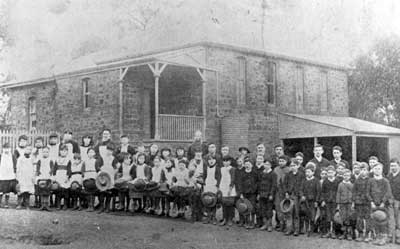
Millbrook School students with Mr J.H. Risley (Photo Peg & Bill Chartres' collection Circa 1879-1894) | 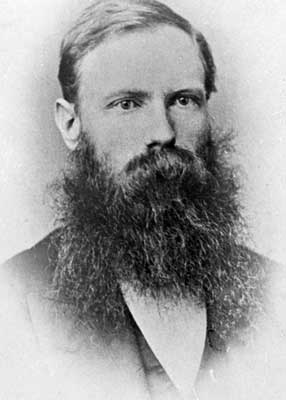
Mr John H. Risley Head Teacher Millbrook Public School 1879-1894 Photo Peg & Bill Chartres' collection Circa 1880's | 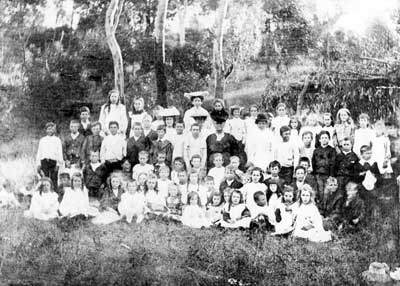
Millbrook School students with Mrs Mary Belcher (Centre of photo in black hat) Photo Peg & Bill Chartres' collection Circa 1895-1912 |
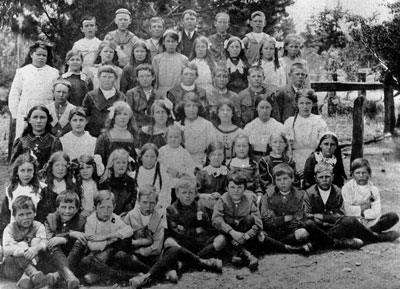
Millbrook School Students 1914 Class of Mr John F Davis Photo Peg & Bill Chartres' collection Circa 1914 | 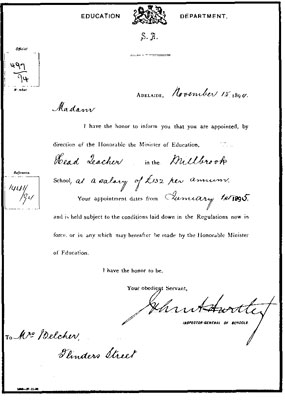
Mrs Mary Belcher's Form of Appointment as Millbrook Head Teacher 1894 Source Peg & Bill Chartres' collection | 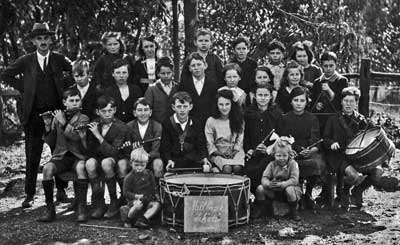
Millbrook School Students 1922 with Mr Herbert Clapton Photo Peg & Bill Chartres' collection Circa 1922 |
In later years the parents were much more involved in the running of the school.
The Millbrook School Centenary 1879-1979 booklet stated;
"Through the war years to 1946 Leslie E.Ashenden was at the helm...
It seems that Millbrook had a dedicated teacher in Ashenden who realised there was much to be learnt outside the classroom.
It was during his period that first mention is made of excursions, physical education programs parent involvement, picnics and concerts as well as the patriotic fervor in working for funds to help the war effort.
Ashenden's work pleased the inspectors as borne out by the inspector's note in 1946 that "Millbrook is a diligent and happy school.""
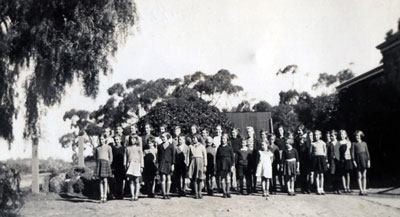
Millbrook School students Photo Peg & Bill Chartres' collection Circa 1940-1946 | 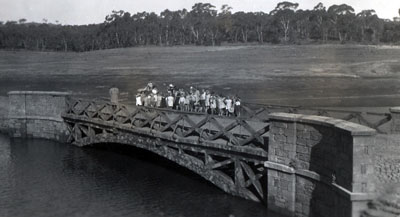
Teacher L E Ashenden Photo Peg & Bill Chartres' collection Circa 1945 | 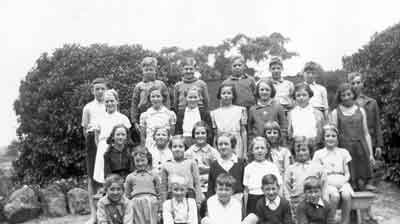
Millbrook School students Photo Peg & Bill Chartres'
collection Circa 1940-1946 |
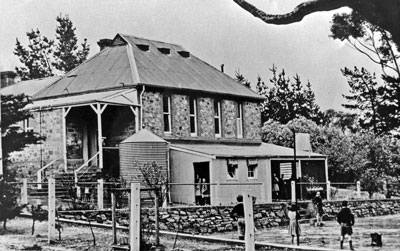
Back to Millbrook 1958 Photo Peg & Bill Chartres'
collection Circa 1958 | 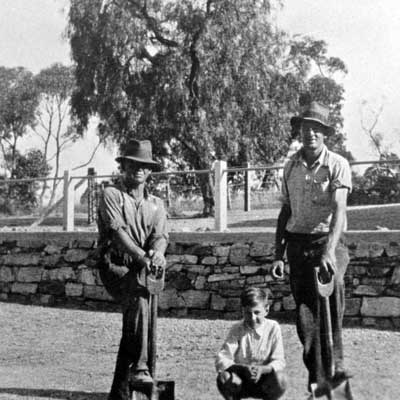
Parents involved in the construction of the
Tennis Courts Photo Peg & Bill Chartres'
collection Circa 1942 | 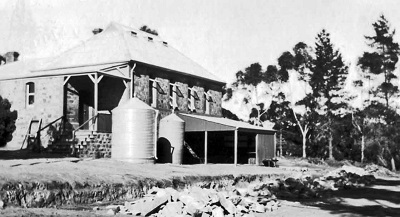
Millbrook School showing stone to be used
for the construction Photo Peg & Bill Chartres'
collection Circa 1942 |
BACK TO MILLBROOK
4th October 1958
A "Back to Millbrook" fete was held on 4th October 1958
It was estimated that about 600 people attended, including old scholars, teachers and friends.
![]()
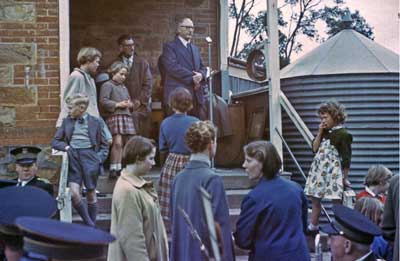
Back to Millbrook 1958 Photo Peg & Bill Chartres' collection Circa 1979 | 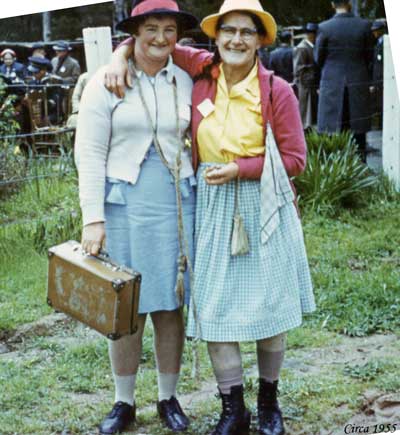
School friends, 1958... Photo Peg & Bill Chartres' collection Circa 1979 | 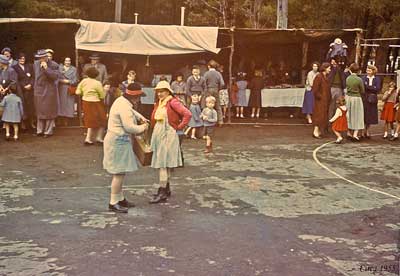
...at play.
Photo Peg & Bill Chartres'
collection Circa 1979 |

Back to Millbrook 1958 Photo Peg & Bill Chartres'
collection Circa 1958 |
MILLBROOK SCHOOL CENTENARY 1879-1979>"100 years on the hill"Millbrook School – The past 100 years
(page 3)
It was to small towns such as these that people came as South Australia's population ventured beyond the
villages of Millbrook and Chain of Ponds. (page 10) How it all began
It's certain that the present Millbrook school was opened in January 1879 with the first day attendance of
26 pupils. By the time of the first inspector's
visit in September the number had risen to 74.
...... Hutchings (page 22) Millbrook boys head the way
From a pupil at a small hills school to Head Master of Adelaide High School. [Mr. Symonds was the Head Master of Adelaide Boys High in 1958 when I did my Leaving Honours (Year 12).] |
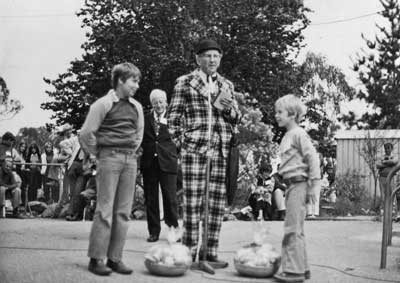
Sixth generation Millbrook School students Nick (Left) & Wayne (Right) Chartres with Baden Cullen (Head Master) Photo Peg & Bill Chartres' collection Circa 1979 | 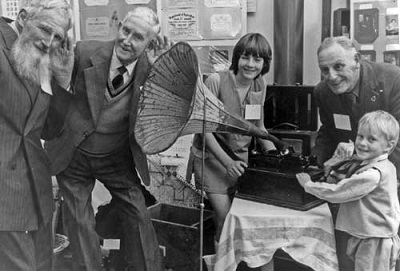 Caption of the photo from The Courier Wednesday, 17th October 1979 Tuning in to the old days! Former pupils Les Redden (80), left, of Cudlee Creek and Tom lambert (76) of Tea Tree Gully remembered the old days when they first listened to instruments like this old Edison. Current pupils Graham Chartres (6) at right, and Shirley Scott (11) didn't know the first thing about the old Edison, but Fred Lambert (82) of Gumeracha was at hand to give them a little advice. Tom and Fred are brothers and their father, William Henry Lambert, was one of the first day pupils in 1879. Young Shirley is the fourth generation of reddens to attend the school and Graham the fifth generation of the Banks Family. His great, great grandfather [Cain Thomas Banks] was another was another first day pupil. Photo "The Courier" Circa 1979 | 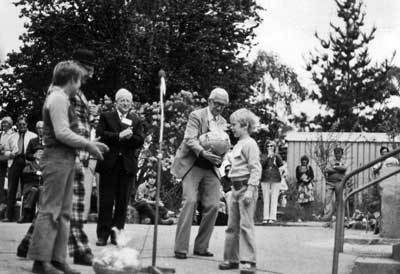
Nick and Wayne Chartres presented baskets of fruit, donated by Bill & Peg Chartres, to Mr Symons and Mr Caust. Photo Peg & Bill Chartres' collection Circa 1979 |
Photos of the School Centenary 1979
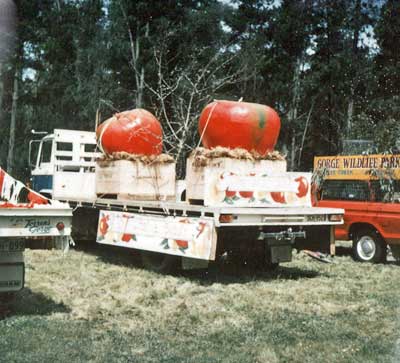
WC Newman's truck for the Centenary parade. Photo Peg & Bill Chartres' collection Circa 1979 | 
Nick, Wayne, Graham and Jason Chartres dressed up as a teacher and students ready for the Centenary parade. Photo Peg & Bill Chartres' collection Circa 1979 | 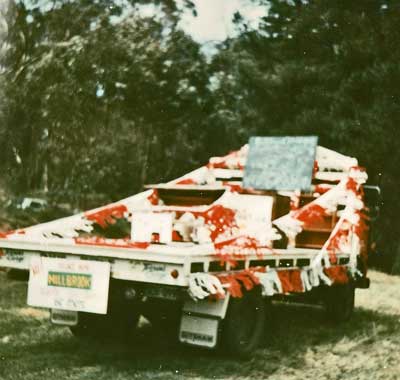
Chartres & Eitzen Pty Ltd truck set up as a school room for the Centenary parade. Photo Peg & Bill Chartres' collection Circa 1979 |
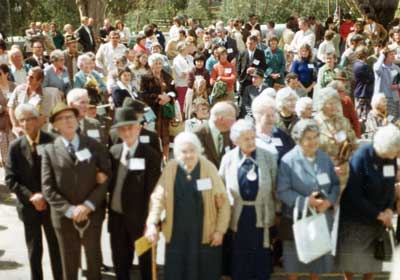
Millbrook School Centenary 1979 Photo Peg & Bill Chartres' collection Circa 1979 | 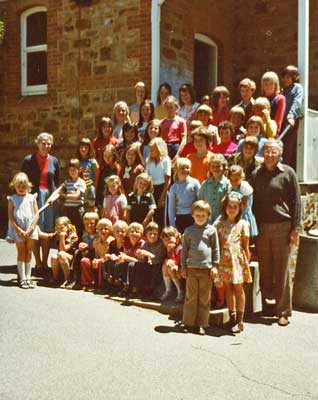
Millbrook Centenary year students with Mr. Cullen Source Peg & Bill Chartres' collection Circa 1979 | 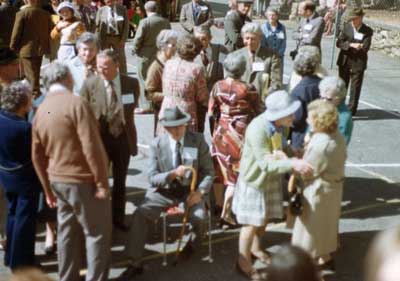
Millbrook School Centenary 1979 Photo Peg & Bill Chartres' collection Circa 1979 |
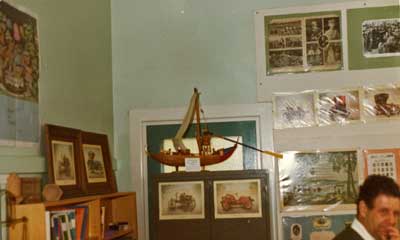
Millbrook School Centenary - Historic Display - 1979. Photo Peg & Bill Chartres' collection Circa 1979 | 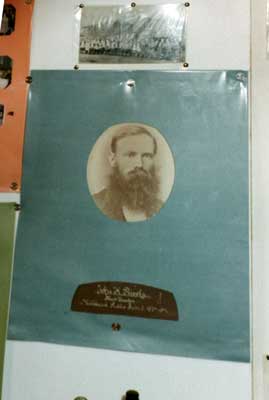
Historic Display - Mr. JH Risley. Photo Peg & Bill Chartres' collection Circa 1979 | 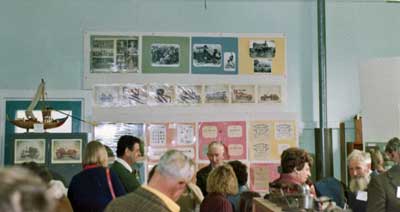
Millbrook School Centenary - Historic Display - 1979 Photo Peg & Bill Chartres' collection Circa 1979 |
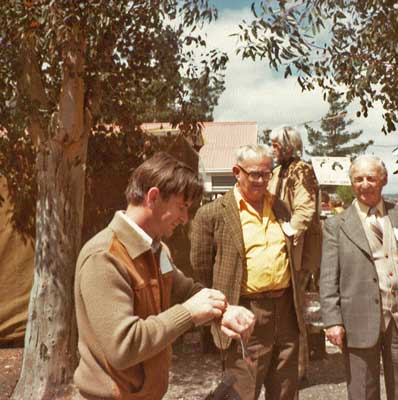
Bill Chartres, Keith Menz and Photo Peg & Bill Chartres' collection Circa 1979 | 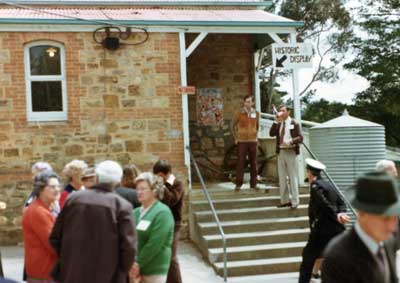
Bill Chartres (left) and Bruce Newman (right) (School Chairman)(on steps) Source Peg & Bill Chartres' collection Circa 1979 | 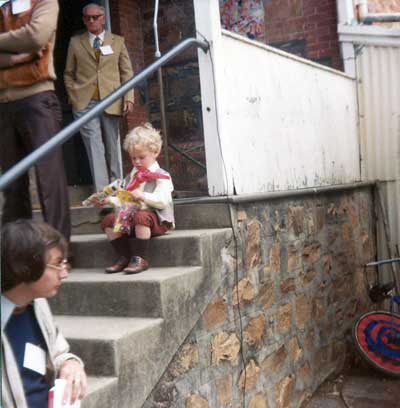
Jason Chartres sitting on the same school steps as his mother (Peggy Menz) had done so many years before, (after being sent outside for talking!) Photo Peg & Bill Chartres' collection Circa 1979 |
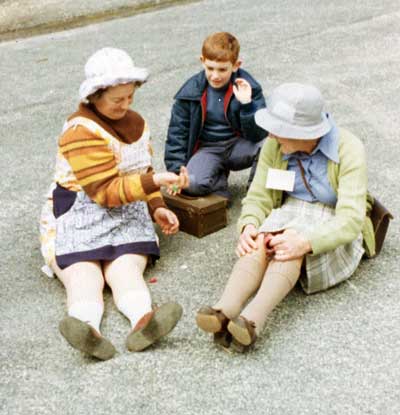
Millbrook School Centenary - Former students at play!. Photo Peg & Bill Chartres' collection Circa 1979 | 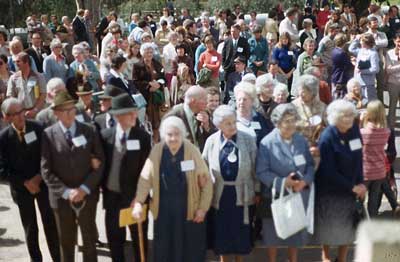
Millbrook School Centenary 1979 collection Circa 1979 | 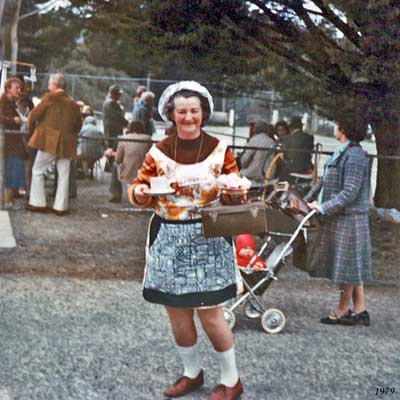
Millbrook School Centenary 1979 Photo Peg & Bill Chartres' collection Circa 1979 |
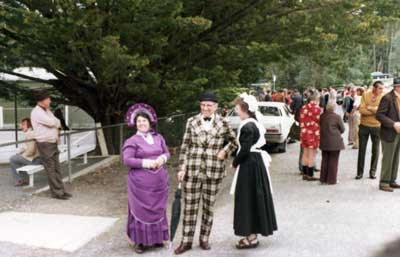
Baden (Centre) & Helen (Left>) Cullen with Photo Peg & Bill Chartres' collection Circa 1979 | 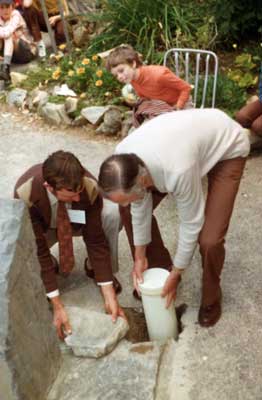
Bruce Newman (School Chairman) and Mr. Caust placing the time capsule Source Peg & Bill Chartres' collection Circa 1979 | 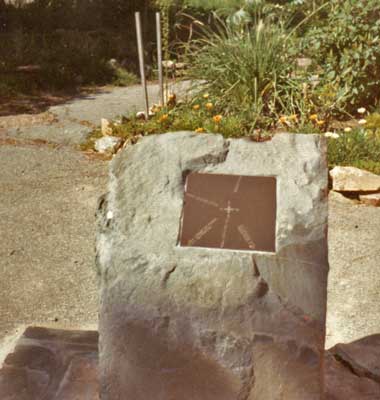
The Symonds-Caust Families Memorial Stone erected in memory of Millbrook Schools early teachers. Photo Peg & Bill Chartres' collection Circa 1979 | 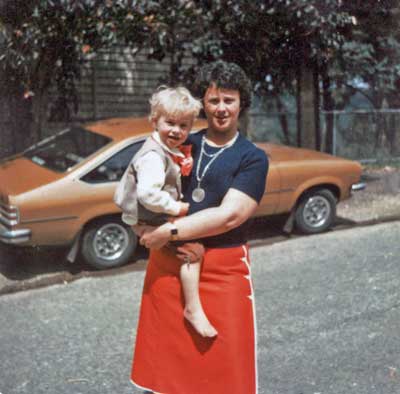
Peg Chartres with son, Jason Photo Peg & Bill Chartres' collection Circa 1979 | 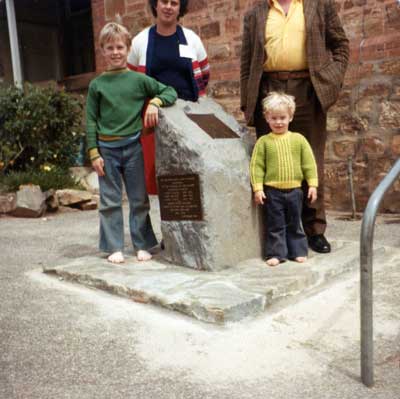
Wayne Chartres, Peg Chartres, Keith Menz (no head)and Jason Chartres with the Teachers Memorial Stone. Source Peg & Bill Chartres' collection Circa 1979 | 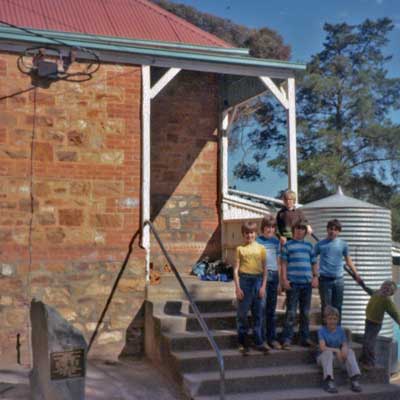
Nick Chartres (Centre Right), Wayne Chartres (sitting), Graham Chartres (Front Right). Photo Peg & Bill Chartres' collection Circa 1979 |
The Millbrook District and surrounding towns has always been considered a beautiful area for both tourists and locals; after the Millbrook Reservoir was constructed this aricle appeared in The Mount Barker Courier and Onkaparinga and Gumeracha Advertiser.
![]()
|
Amongst the many beautiful and enjoyable drives in the hills there are few, if any, that can compare with
the trip from Tweedvale through Cudlee Creek, round the Millbrook
Reservoir, and back again via Gumeracha and Birdwood. The "beautiful" is provided by the magnificent scenery
of hill and valley through which one passes, and the enjoyable
aspects of the outing, of course, depends largely upon the temperament and good fellowship of those making
the trip. A few days ago a small party of "jolly good sports" at
Tweedvale invited the writer to join them in a motor car trip to the Millbrook Reservoir, and, like they
do everything at the happy, pull-together little township of Tweedvale,
the outing in question was carried out in an admirable manner, in fact, in the language of the times, it
can be described as "some trip" -genial companionship, a good car,
good roads, and the other "necessaries" conducive to a pleasant tour of this description. The party comprised
the popular landlord of the Alma Hotel, Tweedvale (Mr. J. M McKay),
his genial predecessor at the Alma (Mr. H. Thiele). Messrs. Otto H. Kleinschmidt, L. Minogue, Chas. Meyer,
and the writer – verily a gathering of scribes and Pharisees, and
publicans, and - no, not a sinner amongst them, not even the thirsty young man who was heard to call for a
corkscrew at the first stop! Ah! Larry, thou art truly an ideal
campaigner on occasions like this, well versed in the ethics of hospitality, and a wonderful judge of human
nature, for one of thy tender years.
('TRIP TO MILIBROOK RESERVOIR.', The Mount Barker Courier and Onkaparinga and Gumeracha Advertiser, 30
April, 1920, p. 2. ,
http://nla.gov.au/nla.news-article146430503) |
About Millbrook Township and Millbrook Reservoir Cudlee Creek, South Australia.
Millbrook Township, Millbrook Reservoir, Cudlee Creek, SA, Australia.
The District of Millbrook is located in the Adelaide Hills approximately 23kms from
Adelaide, the capital of South Australia. Covering an area of about 12 square kilometres,
it is bounded by, Inglewood in the west, Cudlee Creek in the south, Gumeracha in the east
and Kersbrook to the north.
The Millbrook was settled in the early 1800's
(it was originally known as Jollytown)
and was home to a private primary school and hotel.
The township was later demolished to make way for the Millbrook Reservoir.
Buildings at this location included a small private school and the Millbrook Hotel
which was a popular stopover for travelers.
Millbrook is now most renowned as the location of the Millbrook Reservoir,
operated by the South Australian government as part of Adelaide's water supply,
and today remains as a pumping station for the Kangaroo Creek reservoir.
The Millbrook Primary School (which was built on a hill above the township in 1878),
was the only building not demolished to make way for the reservoir, but was destroyed
during the Ash Wednesday fires in 1983.
New classrooms were subsequently built,
but the school was closed in 2010.
The shell of the original building was later restored and is now a private residence.
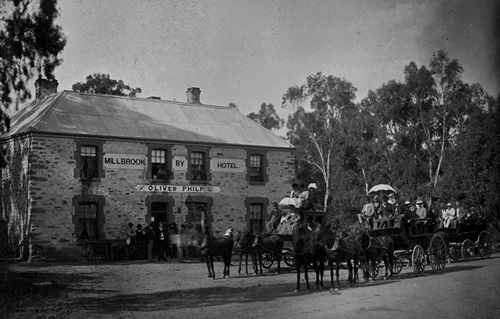
Millbrook Hotel
The Parliamentary Party from the
Pastoral Lands Commission are in
the stagecoaches during a visit
to inspect the proposed site
for the Millbrook Reservoir.
The hotel was built by Richard
Jolly c 1856. Oliver Philp
(who married his neice Eleanor Jolly)
Took it over in 1856
The Hotel was later demolished
(along with the rest of the town)
to make way for the Millbrook
Reservoir.
(Photo © Peg & Bill Chartres collection, slsa c1886)
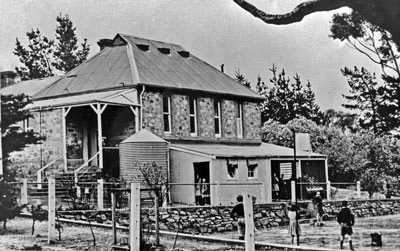
Millbrook School 1958
The Millbrook Primary School
and teachers residence was
built in 1878 with the first
students attending at the
beginning of the 1879 school
year, with Mr. John H. Risley
the Head Teacher.
Our sons (Peg & Bill Chartres),
Nick, Wayne and Graham,
were the fifth generation
of the Banks Family to attend
Millbrook School, their great,
great grandfather [Cain Thomas
Banks], was a first day pupil
in 1878.
(Photo © Peg & Bill Chartres collection, C1958)
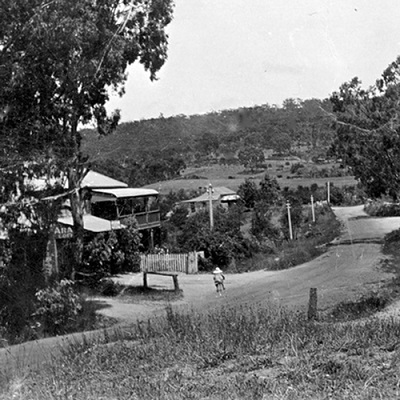
Millbrook Township (originally Jollytown)
The Millbrook Township was
completely demolished and the
landscape cleared for the
construction of the Millbrook
Reservoir Cudlee Creek, South
Australia, Australia.
(Photo © Peg & Bill Chartres collection, C1815)
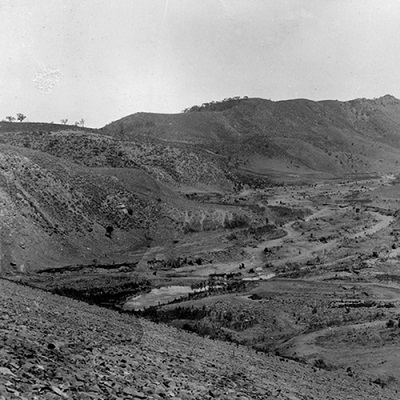
Millbrook Reservoir
Water flowing down the Chain of
Ponds Creek as the Millbrook
Reservoir begins to fill.
The reservoir embankment is
seen in the foreground.
(Photo © Peg & Bill Chartres collection, C1918)
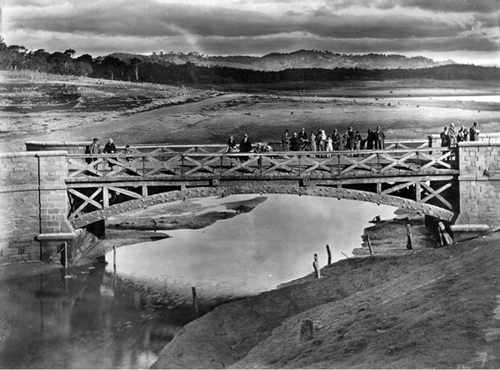
Sunning Hill Bridge
Exposed during a drought 1934.
The bridge was formerly on the
main road to Millbrook before
the town site was submerged by
the Reservoir, and was only
seen during droughts.
(Photo © Peg & Bill Chartres collection, c1934)
<
The Advertiser, Thursday 13 July 1911, page 8
The members of the Royal Commission enquiring into the best means of supplying the
Adelaide higher levels, with water, visited Millbrook on
Wednesday morning to inspect the site of a reservoir from which it is suggested the
Adelaide higher levels might be supplied.
The members were accompanied by the Hydraulic Engineer. Mr. C. A. Bayer, who has
recommended the adoption of the scheme at a cost of £3,000, £200.000 being for head
works and £100 000 for steel and cast-iron mains.
The proposal is to put a concrete dam across the Torrens north of the bridge near
Chain of Ponds, and to take the water through a tunnel a mile long into a reservoir
which would be formed on the Chain of Ponds and Millbrook Creeks, which in themselves
drain 11 square miles of country as compared with 77 square miles which is the catchment
area of the Torrens above Chain of Ponds. It is estimated that a dam 90 ft. high at
a very suitable spot on the Millbrook Creek would
impound 2.550.000,000 gallons, or nearly as much as the Happy Valley reservoir, which holds
2,949.500,000 gallons.
From this reservoir it is proposed to have a main varying from 30 in to 18 in. in diameter
following the valley of the Torrens to the weir and running past Athelstone. Magill,
Burnside, and Mitcham, from which all the high level districts, except Belair and
Blackwood, could be served, if necessary, water could be pumped to Belair from the end
of-the 18in. main at Mitcham, but in this connection the Commission have under
consideration a gravitation scheme which may suit the requirements of Belair and
Blackwood The Commission propose at an early date to examine the Hydraulic Engineer
and residents of the higher levels, and then to present reports to his excellency
the Governor, dealing not only with the higher levels scheme, but with the question
of supplying Eudunda and the Murray Flats.
The Millbrook Reservoir was constructed between January 1914 and 1918 and, when completed,
doubled Adelaide's water storage.
The reservoir controlled the flows of the upper reaches of the River Torrens between
Gumeracha and Kersbrook.
Central to the construction was a tunnel between the Gumeracha Weir
in the River Torrens, and the Chain of Ponds Creek at Kersbrook, which was drilled through
solid rock.
The reservoir was completed in July 1918.

The Banks, Menz and Chartres Families
Cudlee Creek SA A little history of Cudlee Creek
and the Torrens Gorge
